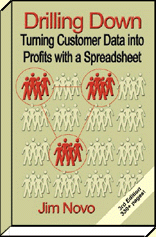Simple CRM: Turning CRM theory into practical
customer service and retention
programs
Jim's intro: Skip Liebman is a strategic partner of mine and
focuses on the "soft side" of customer retention - service
process, procedures, and employee training/recognition - as opposed to crunching numbers like I do. You need both to really make a dent in
customer retention issues, and there are broadly 3 steps to success:
1. Measure - quantify your retention problem.
What kinds of customers are you losing? How many of each
kind? What is their value?
2. Manage - set up systems, process, and procedure to
attack the now identified problems.
3. Maximize - create a feedback loop by tracking what
works and using this knowledge to engage in continuous improvement.
My work is mostly about #1 and #3. Skip does #2, and he's
going to share some highlights of what goes on inside our Simple
CRM progam.
A Guest Opinion by Skip Liebman
First published 1/3/2002
Most organizations spend large sums of money prospecting for new customers.
This type of marketing strategy is often referred to as "Top-Of-The-Mind" marketing."
It's utilized as a marketing method by organizations to create top-of-the-mind purchasing awareness for the goods and services they want to sell customers.
The idea is to market the organization so when customers are ready to buy what the organization offers for sale, the customer will automatically think of the organization first, rather than a competitor.
Top-Of-The-Mind marketing is also directed to veteran customers (those customers already doing business with the organization) to remind them that the organization's doors are still open for business, or that a website is still up and running ready to take a share of the customers hard earned money.
Yes, this type of marketing effort can potentially drive the customer to your phones and to the pages of your catalogue or website.
But what happens from that point forward? Do you wonder if after you woo or win the customer (thanks to
Top-Of-The-Mind marketing), their experience leaves them disappointed, frustrated or angry?
When this occurs, I can assure you that your organization will be at the top if the customer's mind.
The problem is the thought that immediately follows - I don't think I will be doing business in the
future.
Top-Of-The-Mind marketing may attract customers but it does not keep customers.
Consequently, organizations looking for sustained growth must combine top of the mind marketing with
"Customer-Centered" Marketing and Data-Driven
Marketing created around the customer, by the organization and the customer, for the customer.
This approach delivers customers the type of service experience they value.
And delivering it to the right customers - those who will most likely respond or
react - helps keep customers coming back for more, and more often.
What is "Customer-Centered" marketing all about?
We're talking about a Service Discipline.
A result-oriented discipline that positions your organization to retain more of its customers by redirecting organizational resources (time, money, and people) toward the organization's most important assets, those wonderful people called customers.
We're talking about customer retention. Keeping best customers loyal, moving satisfied customer toward loyalty, rescuing at-risk customers
(customers who are about to jump ship), and re-establishing relationships with those customers who are potentially lost to the competition
(past customers who have already jumped to another ship).
We're talking about series of highly productive service plans with winning processes and
procedures. When these plans are united with the right behavior and activities they will help keep
customers rather than allowing them to escape into the waiting arms of
the competition.
We're talking about managing dollars. Taking dollars you already
spend on Top-Of The-Mind marketing, sales training, and assorted operational efforts and redistributing a percentage of those budgets to keep those customers you already have.
You will increase revenues while decreasing expenses by using this Data-Driven Marketing
approach.
We're talking about taking a service discipline (dare we call it
CRM?) that until recently was only thought of in a large businesses
context, and putting it to work for small to mid-size business to
track and improve service while monitoring service-marketing efforts to insure
accountability and increased profits. And
doing all this without a lot of fancy new software and the increased
expense that goes with it.
In future articles, we'll be talking about how you can accomplish all of this regardless of your size,
customers, or budget.
Jim here: Hey you number crunching geeks, stay tuned for
the rest of this monthly series on "the soft side" of
customer retention. Sign up for the newsletter
and you
won't miss a single part of this great series from Skip.
Skip Liebman is a customer service expert with over 25 years experience specializing in the implementation of result-oriented Strategic Service Systems and service training.
During the past seven years he has delivered over 600 customer service training seminars and performance workshops to 25,000 business people
nationwide in a broad range of industries.
What would you like to
do now?
Go
to Part 2: Simple System
Find Out About
Customer Retention Workshops
Learn Customer
Marketing Models and Metrics (site article
list)
|
